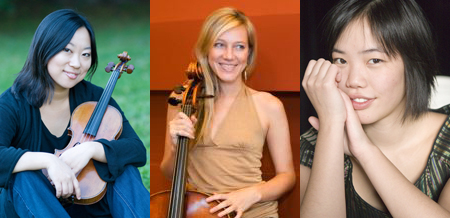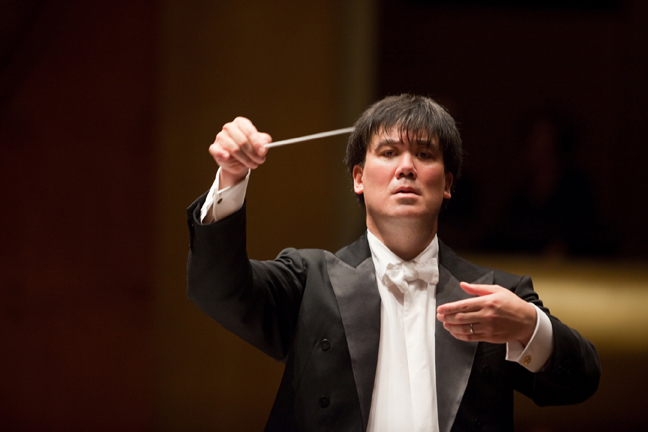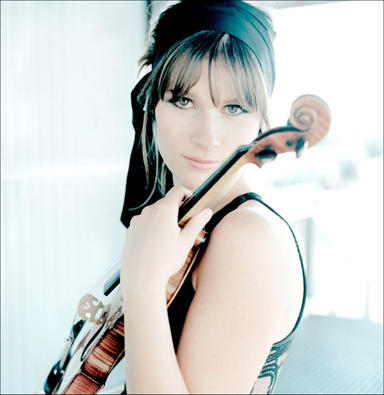If there is a general complaint about manyof today’s performers, it is that they reverse the ancient dictum “Nothing to excess” by doingeverything to excess. Tempi keep getting faster, dynamics louder and softer, contrasts more violent; brass and percussion dominate the orchestral texture and ruin the balance. Nevertheless, there was much to enjoy and admire in this season’s concerts, which honored the anniversaries of Mendelssohn’s birth and Haydn’s death, and also prominently featured Mahler and Brahms; here are some highlights and celebrations.
The year’s biggest news was the passing ofthe baton from Lorin Maazel to Alan Gilbert at the New York Philharmonic. Amid a flurry off are well concerts, Maazel conducted one of his favorite works: Britten’s War Requiem. Despite the excellent performance, the impact of the music seemed to have diminished over the years, but the poetry and the aching memories of the work’s creation are still deeply affecting.
For his tenure’s grand finale, Maazel led amemorable performance of Mahler’s Eighth Symphony. Its monumental length had coherence, its massive score remarkable transparency; there was time to savor the lyrical moments and echoes of other works. It was a triumphant farewell, rewarded by an outpouring of respectand appreciation.
The Philharmonic’s Opening Gala included the Premiere of “EXPO,” commissioned from Magnus Lindberg, the Orchestra’s Resident Composer, and an elusive, impressionist cycle of love songs by Messiaen, which the wonderful soprano Renée Fleming had learned for the occasion. It was the most ambitious Gala program ever devised, and immediately demonstrated the adventurousness of Gilbert’s ideas and his ability to carry them out.
The Philadelphia Orchestra under Christoph Eschenbach gave Mahler’s SeventhSymphony a splendid performance, distinguished by its combination of sweep and attention to detail, its unusual clarity, and especiallits meticulous balance between sections and within the orchestral texture.
Mostly Mozart paid homage to Mendelssohn with his “Italian” Symphony, played very fast under Yannick Nézet Séguin; the Violin Concerto, played brilliantly by the golden toned Joshua Bell under Music Director Louis Langré, and the first Piano Trio with the fine Trio con Brio. Haydn was honored with symphonies, piano concertos, and the rarelheard Sinfonia Concertante, played splendidl by concertmistress Krista Bennion Feeney, cellist Ilya Finkelsteyn, oboist Randall Ellis, and bassoonist Marc Goldberg. Brahms’ Variationson a Theme by Haydn were also featured, preceded by an impressive performance by Jon Manasse and Jon Nakamatsu of Brahms’ first Clarinet Sonata, and followed by his Fourth Symphony. Langré closed the Festival with a lovely performance of Haydn’s “Creation,” sunin English, probably for greater accessibility. The “Creation” and “The Seasons were sung in German by the Monteverdi Choir withthe period instrument group Orchestre Révolutionnaire et Romantique under John Eliot Gardiner. The performances were clear, brisk and enthusiastic, but suffered from all the excesses mentioned above; indeed, the pace was so hectic that Gardiner never even paused between movements, and the balance so lopsided that the strings and the crucial harmoniesin the inner voices were almost obliterated. All four Brahms symphonies were presentedby the Berlin Philharmonic under Simon Rattle, paired with four works by Schoenberg. The combination was supposedly justified by the series’ opening work, Schoenberg’s misguided, blownup orchestration of Brahms’ first Piano Quartet a transcription some chamber musicians dislike. The rest of the programs, however,made up for it. Schoenberg’s monodrama, “Erwartung” (Expectation) was riveting, with soprano Evelyn Herlitzius as a woman who stumbles through a dark forest searching for her faithless lover, only to find his corpse. Reality ornightmare? No one knows. The orchestra was terrific; the soloists were wonderful, the sound was gorgeous. Rattle, deeply involved, alternated between standing still and erupting into violent action; the players, themselves physically very engaged, responded to his slightest motion. The performances were grandly conceived and executed, but intonation and attacks were often imperfect; the texture was murky, everything was so loud that the climaxes became deafening. All concerts ended with a joyful noise; the audiences loved it. Rattle also conducted the Philadelphia Orchestra and Chorale in Berlioz’ “Damnation of Faust.” With mezzo soprano Magdalena Kozena, tenor Gregory Kunde, basses Thomas Quasthoff and Eric Owens, the performance was fabulous and captured both the music’s simplicity and sophistication.With the New York Philharmonic under Gilbert, Frank Peter Zimmermann gave Brahms’ Violin Concerto a robust, extroverted performance, very prosaic despite many juicy slides. It was paired – again – with Schoenberg: the symphonic poem “Pelleas et Melisande,” anearly, tonal, romantic work; players and conductor reveled in its luxurious, colorful orchestration. The Zukerman Chamber Players, with Zukerman on viola, opened their series with adelightful, heartwarming mostly Brahms program. It featured his ingratiating first Sextet and the songs for mezzo soprano and viola, sung superbly by Michelle DeYoung with pianist Kevin Murphy, along with songs by Dvorak and Strauss. The Pacifica Quartet, a young but alreadhighly acclaimed group, has taken over the Guarneri Quartet’s residency at the Metropolitan Museum. This requires self confidence and courage, but perhaps also more introspection than was evident at its opening program. The players’ involvement seemed physical rather than emotional; the playing was competent but too fast and driven for real expressiveness; the sound was good but unvaried; the cello was under balanced. Their Mozart lacked graceand repose, their Brahms depth and passion; they broke up Janácek’s “Intimate Letters” withlong pauses.The Kalichstein Laredo Robinson Trio gave both Schubert Trios a solid, expressive performance; the Emerson Quartet’s Schubert was disciplined and polished, but too extroverted; the American Quartet’s “Death and the Maiden” was brilliant, full of drama and anguished pleading. Violinist Christian Tetzlaff performed one of his specialties, Bach’s unaccompanied works, in one day a remarkable feat. He has recorded them twice, and, claiming that they tell a continuous story, always presents them chronologically. His interpretation continues to gain depth and freedom; unfortunately, the fast movements also gain speed: the performance left listeners breathless, though marveling at his technical control, his pure, beautiful tone, his clear structure and counterpoint. Two great pianists performed Beethoven’s last three sonatas. Mitsuko Uchida projected dramatic intensity and expressive lyricism; András Schiff, concluding his Beethoven cycle, displayed his usual beautiful singing tone and perfect legato, and gave pristine clarity to usually blurred, muddy passages. James Levine, Music Director of the Boston Symphony (and the Metropolitan Opera), had tocancel several appearances due to a back operation. At Carnegie Hall’s Opening Night, he was replaced by Daniele Gatti; the program included Chopin’s second Piano Concerto with the incomparable Evgeny Kissin and the premiere of John Williams’ Harp Concerto, written forthe Orchestra’s harpist Ann Hobson Pilot. There were also other unusual offerings. Leon Kirchner’s four string quartets were played splendidly by the Orion Quartet, to whom one isdedicated. Zemlinsky’s Lyric Symphony, performed by the New York Philharmonic under Neeme Järvi with soprano Hillevi Martinpelto and baritone Thomas Hampson, was very interesting. Set to poems by Rabindranath Tagore, it is romantic, tonal but dissonant; the orchestration is kaleidoscopic, but too heavy for the singers.
by Edith Eisler for New York Concert Review; New York, NY




 Despite a huge snow storm and a prediction of one, people came out in droves to the large Stern Auditorium at Carnegie Hall to see Emanuel Ax and Joshua Bell. In many ways, violin and piano recitals sound best in smaller, more intimate spaces for which they were intended, but Ax and Bell sell lots of tickets and they need a space that can meet demands. On February 10th, 2010, Manhattan received about 10 inches of snow—not nearly as much as Washington D.C. got the week before—but nonetheless, it was enough to potentially scare people away. Good thing Emanuel Ax has such a great following; the many that attended were treated to a 200th Anniversary celebration of Chopin and Schumann’s birth. Ax was at his best in music by Chopin: the Polonaise-fantaisie in A-flat, the Andante spianato and Grand Polonaise, and especially three Mazurkas: the op 41, No. 1 in C-sharp Minor; the Op. 24, No. 2 in C Major and the Op. 56, No. 3 in C Minor. The young Brit Thomas Ades wrote three mazurkas of his own for the occasion, and they are charming—although they don’t really sound like mazurkas. The first one was almost a carbon copy of Prokofiev, but the last two were quite inventive, with unusual leaps and harmonies. Throughout the program, Ax often used his soft-pedal, and his subdued, semi-passionate performances of Schumann’s Fantasiestucke and Fantasy in C Major lacked some grandeur and spontaneity in faster passages. His encore, the Chopin Waltz in A minor, was also one of his more automatic-pilot performances. Maybe his performance inadvertently hurried as a result of subconsciously and altruistically wanting people to get home after a stormy day. (I know; it’s a stretch)
Despite a huge snow storm and a prediction of one, people came out in droves to the large Stern Auditorium at Carnegie Hall to see Emanuel Ax and Joshua Bell. In many ways, violin and piano recitals sound best in smaller, more intimate spaces for which they were intended, but Ax and Bell sell lots of tickets and they need a space that can meet demands. On February 10th, 2010, Manhattan received about 10 inches of snow—not nearly as much as Washington D.C. got the week before—but nonetheless, it was enough to potentially scare people away. Good thing Emanuel Ax has such a great following; the many that attended were treated to a 200th Anniversary celebration of Chopin and Schumann’s birth. Ax was at his best in music by Chopin: the Polonaise-fantaisie in A-flat, the Andante spianato and Grand Polonaise, and especially three Mazurkas: the op 41, No. 1 in C-sharp Minor; the Op. 24, No. 2 in C Major and the Op. 56, No. 3 in C Minor. The young Brit Thomas Ades wrote three mazurkas of his own for the occasion, and they are charming—although they don’t really sound like mazurkas. The first one was almost a carbon copy of Prokofiev, but the last two were quite inventive, with unusual leaps and harmonies. Throughout the program, Ax often used his soft-pedal, and his subdued, semi-passionate performances of Schumann’s Fantasiestucke and Fantasy in C Major lacked some grandeur and spontaneity in faster passages. His encore, the Chopin Waltz in A minor, was also one of his more automatic-pilot performances. Maybe his performance inadvertently hurried as a result of subconsciously and altruistically wanting people to get home after a stormy day. (I know; it’s a stretch) If any orchestra should tour with Holst’s “The Planets”, the Houston Symphony should—due to its relationship with NASA and the Johnson Space Center. But a film experiment directed by Duncan Copp called “The Planets: an HD Odyssey” didn’t work: the space images and video, though extraordinarily clear and beautiful, were too generic for Holst’s mythical descriptions of the planets and our own imaginations that inevitably follow. It was like experiencing an orchestra play James Horner’s riveting music to the film
If any orchestra should tour with Holst’s “The Planets”, the Houston Symphony should—due to its relationship with NASA and the Johnson Space Center. But a film experiment directed by Duncan Copp called “The Planets: an HD Odyssey” didn’t work: the space images and video, though extraordinarily clear and beautiful, were too generic for Holst’s mythical descriptions of the planets and our own imaginations that inevitably follow. It was like experiencing an orchestra play James Horner’s riveting music to the film